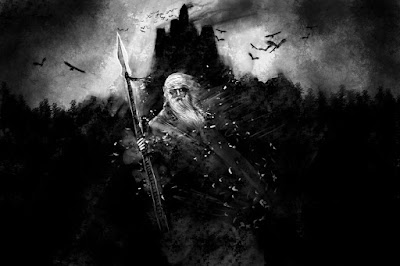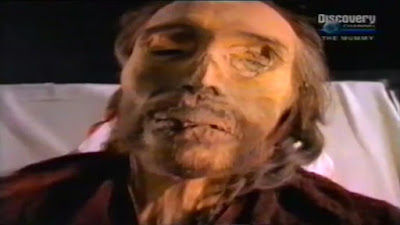Was Odin Human?
Thor Heyerdahl and Per Lilliestrom believe they have found possible evidence for Odin being an actual human being in their work Jakten pa Odin (The Search For Odin). They believe he was the chief of a people called the Asas in a region near Azov lake in Southern Russia. In their work, they also make a connection with China, believing the human leader to be a shaman, blessed with long life, and wandering the Earth.
A synopsis of this work can be found here The Search For Odin
Chinese lore is full of encounters with strange looking people with red beards who were quite tall. These were always regarded as fairy tales, as the possibility for such an encounter before the modern era was considered impossible. The 20th Century would prove that these were no fairy tales..
In the early 20th Century, archaeologists stumbled upon an enigma; the mummified remains of a young man was found enclosed in a crude coffin. His attire was non-Asian, and the features of his ancient face seemed European. The team dismissed their discovery as unexplainable. Europeans in ancient China just seemed too fantastic. In 1979 an excavation team in Western China discovered a shallow depression containing strange pottery fragments. Layers of ancient logs were removed... they thought that if this was a burial, it was unlike anything they had ever seen. They had discovered the mummified remains of a middle-aged man. It was the skull of this mummy that startled the team; once they saw the low, wide-set eyes and strongly projecting nasal opening, they knew they were looking at an ancient Caucasian. There were many shallow depressions in the area. Archaeologists then hoped that hidden within these shallow graves were answers to a bottomless mystery; who were these people and why were they so far from their ancestral homeland?
The fabrics on the mummified remains gives proof of their origin. Irene Good of the University of Pennsylvania was brought in to examine the fabrics. Good scanned a color photo of a cloth sample she was given into a computer. The scan enabled her to construct an image of how the fabric would've looked when new. Good stated, "I was awe struck. A twill weave is something we're all familiar with, it's the same weave found in denim. A twill weave is characteristically European... the patterns on the fabric are what we would call plaid, possibly part of some kind of tartan." The wool fibers were magnified hundreds of times. Good compared the fibers with indigenous Asian sheep. The type of wool wasn't found anywhere in the Asian sheep, but did match other samples from Iron-age Europe. The cloth was more than Western in design, it was Western to the very fiber.
In 1985, archaeologists struck gold in Charchan Co. in the province of Xinjiang. Hundreds of well preserved mummies were found, the most astonishing were "Charchan man" (approximately 3,000 years old) and "Charchan woman" (approximately 3,200 years old). The two were so well preserved that they appeared to be more asleep than dead. It's interesting to note that both corpses had symbols painted on their faces, arms, and hands.
"Charchan Man." Who was he? What was his true identity? Was he the Allfather himself?
"Charchan Woman." What was her true name? We can only imagine whom she might have been.
Pagan holy ground found near Loulan Co. Six mummified remains were discovered here, all Caucasian, the oldest some 5,000 years old.
Now that we know for certain that Europeans inhabited a portion of Western China thousands of years ago, there is only one question left. WHY?
At the edges of the Taklamakan desert in the Xijiang region, there are island oasis. Melting ice from the mountains helped to form lush landscapes of green pastures. The fertile land was perfect for agriculture and animal husbandry. The desert was apparently used for burying the dead, while the outer oasis occupied a thriving economy for the living. It is said that man became a master of time and space when he learned to ride a horse. And it's here we begin to answer some important questions.
Island oasis at the edge of the Taklamakan desert.
There is evidence of long distance trade from the mountains to the Northern steps, all made possible through horseback riding. Though there is controversy as to the exact time frame when horses became domesticated for riding, the best estimate is that the first riders lived more than 5,000 years ago. It is believed they were first domesticated in Eastern Europe, with the domestication spreading West to Scandinavia, and East Toward Siberia, eventually making its way to Western China approximately 3,000 years ago. The European mummies are thought to have been traders; trading livestock, weapons, tools, even religious practices. These ancient nomads, like the ice-age hunter gatherers that came before them, would have had temporary housing near various trading outposts, enabling them to travel with some comfort between Western China and Eastern Europe.
Odin's horse, Sleipnir.
Fertility rites carved into the mountain side, overlooking a lush oasis. Approximately 3,000 years old. These carving are nearly identical to those found in Bulgaria and the Ukraine some thousand years prior (pictured below).
Odin is sometimes referred to as "The Wanderer", a title indicating a nomadic lifestyle. If there truly is remnants of a tribe bearing the name Asas, and it really is the foundation for the Aesir... then there is strong evidence supporting the claim. Odin may very well be buried somewhere in the Taklamakan desert, if he hasn't been found already.
Author Marc Rice is an Armanen Runemaster and Hermeticist. His books and videos can be found HERE
Tags:
Replies to This Discussion
-
Permalink Reply by Carmen Elsa Irarragorri Wyland on June 6, 2016 at 1:50pm
-
-
-
Permalink Reply by Poppy Whiteheart on September 27, 2016 at 4:20am
-
I would like to push that figure when Odin walked the Earth to 10,000 before the date that they said, when Giants walked the earth. 5.000 - 3,000 year old carvings? they can not carbon date stone or rock.. so they place the figure of 5.000 yr to go with what is written in the bible and the start of mankind ..
-
-
Permalink Reply by Carmen Elsa Irarragorri Wyland on September 29, 2016 at 9:17pm
-
You might be right Poppy!
-
Have questions?
Need help? Visit our Support Group for help from our friendly Admins and members!
Have you?
Donations & Sponsorship
Connect
Visit The Temple
on Facebook:
Blog Posts
SEAL SIGNET -vs- CATTLE BRAND
Posted by FRA .*. DISTURABO .*. on September 3, 2025 at 4:30pm 0 Comments 0 Likes
NEO SLAVERY
Posted by FRA .*. DISTURABO .*. on September 1, 2025 at 7:36pm 0 Comments 0 Likes
888 -vs- 666
Posted by FRA .*. DISTURABO .*. on September 1, 2025 at 7:30pm 0 Comments 1 Like
SOUL CONTRACT REVOCATION FORM (sample)
Posted by FRA .*. DISTURABO .*. on August 31, 2025 at 8:16pm 0 Comments 1 Like
THE THREE CITY STATES
Posted by FRA .*. DISTURABO .*. on August 31, 2025 at 6:33pm 0 Comments 2 Likes
No Lie
Posted by Heth Lee (李) on August 30, 2025 at 7:30am 0 Comments 0 Likes
Channeled Angelic Wisdom of the Jewels of Truth Series on Fairness, Empaths Alchemize, & the Angelic Highest Self
Posted by Atrayo on August 27, 2025 at 7:27pm 0 Comments 2 Likes
the Covenant
Posted by Heth Lee (李) on August 23, 2025 at 1:00pm 0 Comments 0 Likes
COMET OR SPACESHIP?
Posted by Sky a.k.a. JD Aeon on August 19, 2025 at 4:30pm 0 Comments 2 Likes
ABOUT REINCARNATION / PAST-LIVES REGRESSION - ETC
Posted by Sky a.k.a. JD Aeon on August 15, 2025 at 5:00pm 2 Comments 1 Like
Could Reincarnation Play A Part in Being Gay
Posted by Bill Walker on August 14, 2025 at 10:24pm 2 Comments 0 Likes
Gaia's Coming Rage
Posted by Bill Walker on August 5, 2025 at 12:12am 1 Comment 1 Like
Channeled Angelic Wisdom of the Jewels of Truth Series on Virtues & Vices and Holy Spirit Activation
Posted by Atrayo on August 3, 2025 at 2:24pm 0 Comments 2 Likes
A Spiritual Background Of The Origins Of The Jewels of Truth Series With A 30th Year Celebratory Anniversary
Posted by Atrayo on July 28, 2025 at 1:00pm 0 Comments 1 Like
Channeled Angelic Wisdom of the Jewels of Truth Series on Faith with Cascading Blessings and Worship
Posted by Atrayo on July 28, 2025 at 1:00pm 0 Comments 1 Like
Channeled Angelic Wisdom of the Jewels of Truth Series on Chaos & Lust
Posted by Atrayo on July 22, 2025 at 9:00am 0 Comments 0 Likes
FLEET OF LIGHT!
Posted by Rosey Cross on July 18, 2025 at 5:07pm 0 Comments 0 Likes
Perdition
Posted by Heth Lee (李) on July 13, 2025 at 12:30am 0 Comments 0 Likes
RICO
Posted by Heth Lee (李) on July 11, 2025 at 6:00pm 0 Comments 0 Likes
Death Wish
Posted by Heth Lee (李) on July 11, 2025 at 6:30am 0 Comments 0 Likes
NOVEMBER AWARENESS
Videos
© 2025 Created by Bryan
Powered by
![]()








Also
In Germanic mythology, Odin (from Old Norse Óðinn) is a widely revered god. In Norse mythology, from which stems most of our information about the god, Odin is associated with healing, death, royalty, the gallows, knowledge, battle, sorcery, poetry, frenzy, and the runic alphabet, and is the husband of the goddess Frigg. In wider Germanic mythology and paganism, Odin was known in Old English as Wōden, in Old Saxon as Wōdan, and in Old High German as Wuotan or Wōtan, all stemming from the reconstructed Proto-Germanic theonym *wōđanaz.
Odin is a prominently mentioned god throughout the recorded history of the Germanic peoples, from the Roman occupation of regions of Germania through the tribal expansions of the Migration Period and the Viking Age. Odin continued into the modern period to be acknowledged in rural folklore in all Germanic regions. References to Odin appear in place names throughout regions historically inhabited by the ancient Germanic peoples, and the day of the week Wednesday bears his name in many Germanic languages, including English.
In Anglo-Saxon England, Odin held a particular place as a euhemerized ancestral figure among royalty, and he is frequently referred to as a founding figure among various other Germanic peoples, including the Langobards and in most of Scandinavia. Forms of his name appear frequently throughout the Germanic record, though narratives regarding Odin are primarily found in Old Norse works recorded in Iceland, primarily around the 13th century, texts which make up the bulk of modern understanding of Norse mythology.
In Old Norse texts, Odin is depicted as one-eyed and long-bearded, frequently wielding a spear named Gungnir, and wearing a cloak and a broad hat. He is often accompanied by his animal companions—the wolves Geri and Freki and the ravens Huginn and Muninn, who bring him information from all over Midgard—and Odin rides the flying, eight-legged steed Sleipnir across the sky and into the underworld. Odin is attested as having many sons, most famously the god Baldr with Frigg, and is known by hundreds of names. In these texts, Odin frequently seeks knowledge in some manner and in disguise (most famously by obtaining the Mead of Poetry), at times makes wagers with his wife Frigg over the outcome of exploits, and takes part in both the creation of the world by way of slaying the primordial being Ymir and the gift of life to the first two humans Ask and Embla. Odin has a particular association with Yule, and mankind's knowledge of both the runes and poetry is also attributed to Odin.
In Old Norse texts, Odin is given primacy over female beings associated with the battlefield—the valkyries—and he himself oversees the afterlife location Valhalla, where he receives half of those who die in battle, the einherjar. The other half are chosen by goddess Freyja for her afterlife location, Fólkvangr. Odin consults the disembodied, herb-embalmed head of the wise being Mímir for advice, and during the foretold events of Ragnarök, Odin is told to lead the einherjar into battle before being consumed by the monstrous wolf Fenrir. In later folklore, Odin appears as a leader of the Wild Hunt, a ghostly procession of the dead through the winter sky. Odin is also particularly associated with charms and other forms of magic, such as in Old English and Old Norse texts.
Odin has been a frequent subject of study in Germanic studies and numerous theories surround the god. Some of these focus on Odin's particular relation to other figures, such as that Freyja's husband Óðr appears to be something of an etymological doublet of the god, whereas Odin's wife Frigg is in many ways similar to Freyja, and that Odin has a particular relation to the figure of Loki. Other approaches focus on Odin's place in the historical record, a frequent question being whether Odin is derived from Proto-Indo-European religion, or whether he developed later in Germanic society. In the modern period, Odin has inspired numerous works of poetry, music, and other forms of media. He is venerated in most forms of the new religious movement Heathenry, together with other gods venerated by the ancient Germanic peoples; some focus particularly on him.